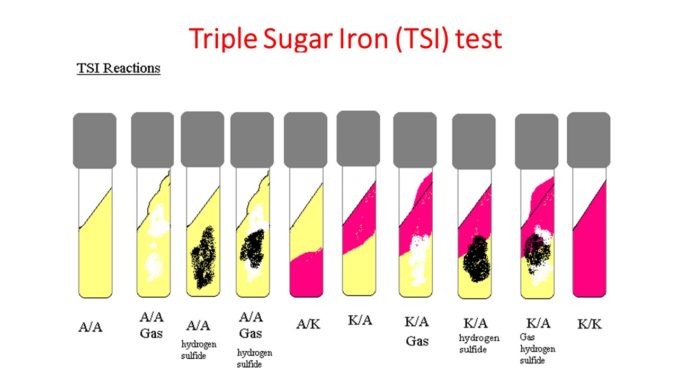
TSI (Triple Sugar Iron) test:
Objective
- to check the ability of organism to ferment sugar (lactose, sucrose) and their ability to produce H2S gas.
Principle of TSI test:
- Triple Sugar Iron Agar (TSIA) contains 3 sugar glucose (dextrose) sucrose, lactose in the ratio of1: 1:10 as the source of carbon as its name suggest. Besides this the media also contains yeast and beef extract, peptic digest of animal tissue and casein as the source of protein.
- The presence of fetrous sulphate and sodium thiosulphate fulfills the demand of sulphur and there is the indicator phenol red for the indication of change in the invironment of the media due to the production of acid or alkali. The media is prepared in the form of slant containing, a slant and butt region.
- This test is used to differentiate gram negative enteric. Enter bacteria and other glucose fermenter first begin to metabolize glucose as glucose utilizing enzymes are present constitutively and bacteria can gain the most energy by using simplest sugar.
- All other sugar must be converted to glucose before they enter the EMP. Glucose utilization occur both aerobically on the slant where O2 is available and on the butt where there is anaerobic condition. Once the glucose fermenting bacterium has reduced all of the available glucose to pyruvate, it will further metabolize pyruvate via TCA cycle to produce acid end products. The acid in the medium cause the ph indicator phenol red, to change its colour to yellow. Thus, after 6 hours of incubation both the slant and butt of TSIA that has been inoculated with a glucose fermenter will appear yellow.
- After the depletion of limited glucose in the medium, the organism that has enzymes to degrade lactose or sucrose starts to utilize them as they are present 10 times more concentration than glucose and the organism continue to make acid end products.
- Hence, the butt and slant of TSIA will still remain yellow for lactose and sucrose fermentors (degrades) after 18 hours of incubation and the reaction is called acid/acid.
- If the organism being tasted cannot use the lactose or sucrose in the medium, it must shift to protein utilization as there is no other source or energy in the media.
- As the protein breakdown occurs only in aerobic condition, the byproduct of protein and amino acid metabolism i.e NH3 changes the pH environment of the medium from the neutral to alkaline in the slant region where the condition is aerobic. Hence, the colour of slant appears red and the reaction is called alkali/acid while the colour of the butt is still yellow due to anaerobic glucose breakdown.
- Gas production can be detected when holes are formed or the medium is broken into several fragments. H2S production by organism results in the blackening of the medium. This colour is due to the production of H2S from an ingredient of the medium, sodium thiosulphate, which then combines with another component of the medium, ferrous ammonium sulphate resulting in the formation of black, insoluble compound, ferrous sulphide.
FeSO4 + H2S ——————> H2SO4 + FeS (Black ppt)
Requirements
- TSIA slant
- Given sample of bacterial cultures (E.coli and Klebsiella)
- Inoculating wire
- Burner
- Incubator.
Procedure of TSI test
- Take 5-7 ml of the autoclaved TSIA media in a sterile test tube and slant was made by tilting the media till it solidified.
- Using a flamed inoculating loop, pick a colony from the bacterial culture.
- Inoculate the organism in TSIA slant by stabbing in the butt and then with the same loop streaking on the whole slant surface of the medium
- Incubate at 37°C for 18-24 hours.
- Observe for the color change in the slant and butt, gas production and H2S production.
Result interpretation:

|
Color observed (Slant/Butt) |
pH (Slant/Butt) |
Utilization |
| Red/yellow | Alkali/Acid | Glucose only and peptone |
| Yellow/Yellow | Acid/Acid | Glucose, Lactose and sucrose |
| Red/Red | Alkali/Alkali | No sugar are utilized, utilize peptone |
*H2S gas production is indicated by blackening of media
** Gas production is indicated by bubbles in butt
- E. coli gives acid/Acid with gas production without H2S production. This means E. coli utilize all sugar anaerobically with production of gas during fermentation.
*** Pseudomonas spp gives alkaline/alkaline (Red/Red) which means it does not utilize any sugar.
